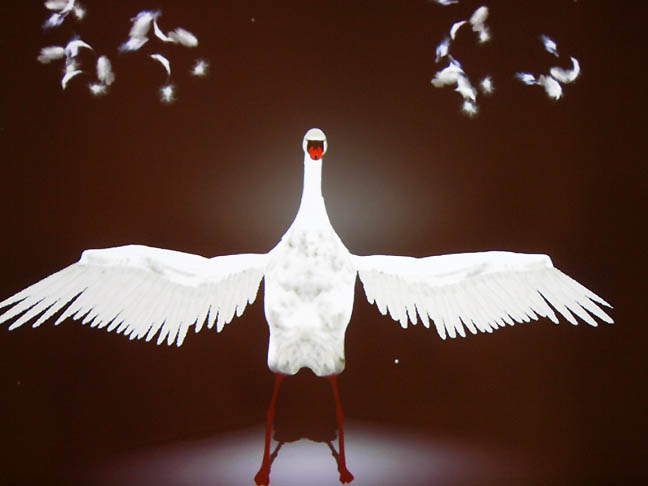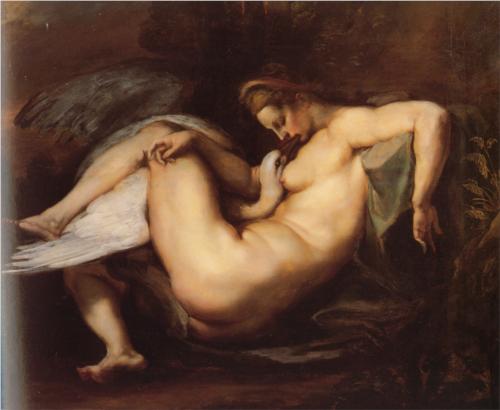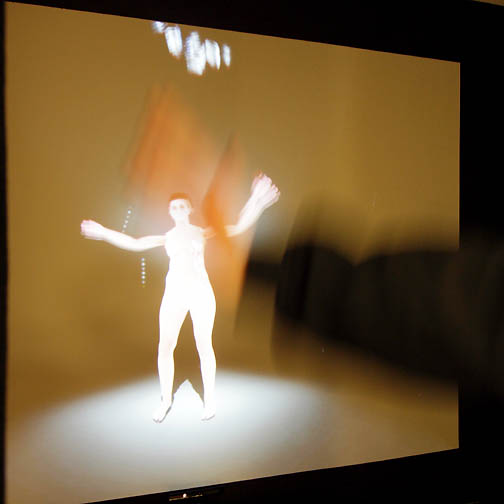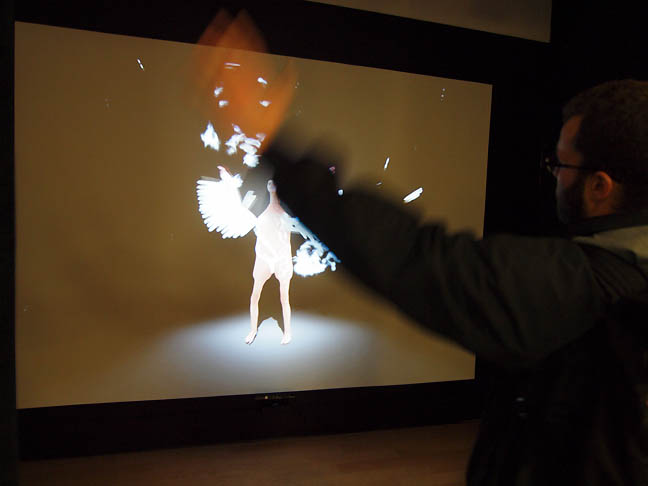
|
||
|
Portland art blog + news + exhibition reviews + galleries + contemporary northwest art
|
||
Paul Clay's Leda and the Swan One of the most successful things about the embattled Portland Building is its art programming in the lobby. As one of the few spaces that specifically caters to multimedia installation art, it even supports the artists by providing a stipend for the work and has been instrumental in the careers of artists like Damien Gilley, Bruce Conkle and Laura Hughes. All found a way to engage the otherwise oppressed workers in this flawed office building and I'm a little surprised such spaces aren't more common considering the success of this program run by RACC (from 2002-3 I was on the selection committee for this space).
 Leda and the Swan by Paul Clay at the Portland Building (all install photos Jeff Jahn) The latest exhibition, by interactive video artist Paul Clay, Leda and the Swan, deserves mention on that list of noteworthy new media artists Portland Building alumni as well. It is loosely based on the Greek myth where Zeus disguised as a swan seduces Leda who had just had sex with her husband, the King of Sparta. The resulting offspring are Helen (of Troy), Clytemnestra and the twins Castor and Pollox. The four progeny are embodiments of various paradoxes like immortality and mortality or desire to possess/destroy, etc. 
Paul Rubens, Leda and the Swan (1600) Later, the Leda and the Swan theme became popular as an erotic motif in western civilization, since it was somehow more acceptable to show women and long necked swans together... rather than an erect penis. Thus, swans became a motif allegorically associated with men. Clay, plays upon these paradoxes by setting up his own gender bending situation with a subtext of identification and consent and seasons it with the relief of becoming a bird while being trapped in the Portland Building's oppressive environs. At first, as the viewer approaches they encounter a video projection of a human sized swan avatar. When the visitor steps within a box outlined on the floor the sensors are triggered and acquire the motion signature of the viewers body and mirrors their motions. What is interesting is the way in which the more the viewer moves the more the white feathers seem to explode off the body, like an existential pillow fight... revealing an increasingly more naked human female form. Thus, use becomes a form of identification. This sort of avatar gender bending situation isn't anything new as video games have long had female avatars (Laura Croft being the most famous) but it is the way Clay makes use of the Zeus' seductive motif to set up a paradox of transformation and the question of how much activity becomes crucial. In the mythic source material there are different readings as to whether Zeus is a seducer or a rapist and the benign bait and switch here deftly sidesteps the question of consent. Basically, use of the installation is consent (not unlike Facebook or Google products) and the more animated the viewer the more dramatic the transformation becomes. 
Paul Clay and avatar Generally, the most interesting forms are somewhere in between and the surprise factor for visitors should be interesting if nothing because the empathy created through the swan/woman avatar would be different if it were a man in the stead of the two forms chosen? The bestiality part of the myth is left out and the blurring between the two is implicit. Partially this is because Clay came to the myth via Cy Twombly's painting, which literally blurs all figurative elements, rather the more allegorical classical versions.  Cy Twombly, Leda and the Swan Perhaps without the mythical baggage the exhibition might fly too close to gimmickry but its underlying ambitions in gender ambiguity give it heft. Besides, it recalls numerous other anthropomorphic bird human situations from the San Diego Chicken to the infamous Disco Duck. There is more than a little fun to be had here as one can pantomime oneself. 
It also deserves mention as art that utilizes empathy with animals. Without the swan it just wouldn't be as approachable, especially in such a public space where viewers can happen upon it while not expecting an art experience. By implicating the visitor as a performer its bait and switch is stronger for not evoking other potentially related stories like the ballet of Swan Lake, where a princes requires rescue from her swan form. Also, by avoiding a black swan and the recent Aronofski film of the same name, wherein a dark doppelganger competes for the white swan role, Clay keeps the discussion on gender identification rather than the supposed darkness of ambition and competition. As one of Portland's most promising young talents this small show by Clay hints at a talent that deserves to be watched. Currently, the acquisition sensors and limited one to one mirroring relationship of the viewer's movements encompass the work's mimetic charm but I can see this sort of immersive avatar situation being developed a lot further. Frankly, more institutions in Portland should be exploring this kind of multimedia work more rather than staying in their comfort zones. Posted by Jeff Jahn on January 15, 2014 at 16:17 | Comments (0) Comments Post a comment Thanks for signing in, . Now you can comment. (sign out)
(If you haven't left a comment here before, you may need to be approved by
the site owner before your comment will appear. Until then, it won't appear
on the entry. Thanks for waiting.)
|
| s p o n s o r s |
 |
 |
 |
 |
 |
 |
 |
 |
 |
 |
 |
 |
 |
 |
 |
 |

|
Site Design: Jennifer Armbrust | • | Site Development: Philippe Blanc & Katherine Bovee | |

